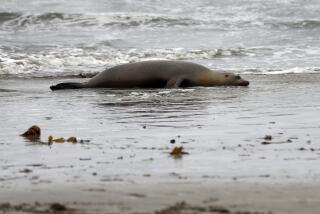‘Killer Algae’ War Almost a Wrap, Except for the Plastic
- Share via
Four years after the first plastic tarps were placed on the ocean floor in Huntington Harbour in Huntington Beach and a Carlsbad lagoon in hopes of eradicating an invasive species known as “killer algae,” marine biologists hope to soon declare victory.
But now they have a new problem: If they remove the tarps, as planned, they will kill a new ecosystem of eelgrass, sea sponges and clams that have grown on top of the plastic.
Like the long-running debate over whether to dismantle abandoned oil rigs that have become artificial reefs sheltering a range of sea creatures, this latest twist in the effort to combat the algae illustrates the challenges of restoring an environment that constantly adapts to human intervention, experts say.
“It’s not going to be a pretty picture if we have to take it out,” said Bob Hoffman, an environmental coordinator for the National Marine Fisheries Service.
“We had to kill parts of [the lagoon] to get rid of the organism in the first place. Do we want to essentially go back and do it all over again just for the sake of removing the tarp? I don’t know that that makes a whole lot of sense.”
The final decision on what will happen to the tarps rests with the California Coastal Commission, Hoffman said, which usually requires removal of materials that don’t belong in the ocean.
The problem that started it all is called Caulerpa taxifolia, a leafy emerald-green Caribbean plant commonly used in saltwater aquariums because it’s colorful and easy to grow. When released into new environments, a single stem, root or leaf can rapidly crowd out native plants and bottom-dwelling marine animals.
In the Mediterranean, the algae have infested more than 10,000 acres of sea floor off Spain, France, Italy and Croatia, ruining fisheries and clogging popular scuba diving sites.
Fearing the algae could do the same along the California coast, a coalition of state and federal agencies called the Southern California Caulerpa Action Team in 2000 launched a $5.2-million effort to combat two outbreaks of the algae, which wildlife officials believe were caused by people dumping their home aquariums into storm drains or directly in the ocean.
Within weeks of the first algae sighting in Agua Hedionda Lagoon in Carlsbad, divers had covered caulerpa patches with large black plastic tarps up to an acre in size. They then pumped liquid chlorine or placed chlorine tablets under the tarps to poison the invasive plant.
In the years that followed, divers have surveyed both sites for caulerpa regrowth and found none. If the plant is declared eradicated by next fall, as anticipated, biologists say it will mark the first time invasive marine algae have been eliminated in the United States. Their efforts will be followed by a $3-million project beginning next year to survey other high-risk areas in California.
To keep the algae from growing back, the tarps were to be left in place until 2005 and eventually became covered with sediment and vegetation.
The reestablishment of plants and animals “is part of the deal whenever you put anything in the ocean,” said Mark Rauscher, interim environment director the Surfrider Foundation, a conservation group. “It’s an interesting quandary.”
But Rauscher is not sure that leaving the tarps in place is the right thing.
“I think it’s always a good idea to go ahead and remove something once you’ve completed the procedure and return it back to its natural state,” Rauscher said. “That was the whole point -- to try to return the lagoon to its natural habitat.”
But Hoffman, of the fisheries service, isn’t so sure.
“My opinion is we’re probably going to do more harm yanking it out than leaving it in,” Hoffman said. “On the other hand, I understand the possible precedent people could see for leaving stuff behind.”
If the tarps were left behind, he said, normal wave action would continue to bury the tarps until they were completely covered.
Hoffman noted that the agency has been treading new ground on this project -- and encountering new challenges along the way.
“I don’t think anyone’s tried this technique before -- isolate an invasive species by putting tarp over it, and then having to deal with the problem of tarps at a later date,” he said.
In cases involving smaller bodies of water, Hoffman said, entire lakes must be drained or treated with chemicals to kill an invasive species.
Removing the tarps, which total four acres in Agua Hedionda Lagoon and half an acre in Huntington Harbour, would cost $500,000.
Rauscher anticipated the coastal commission would take note of how quickly plants and animals settled onto the tarp.
“This stuff has grown in a relatively short period of time,” he said. From that, he guessed that the plants and animals would likely reestablish themselves within a few years.
More to Read
Sign up for Essential California
The most important California stories and recommendations in your inbox every morning.
You may occasionally receive promotional content from the Los Angeles Times.










